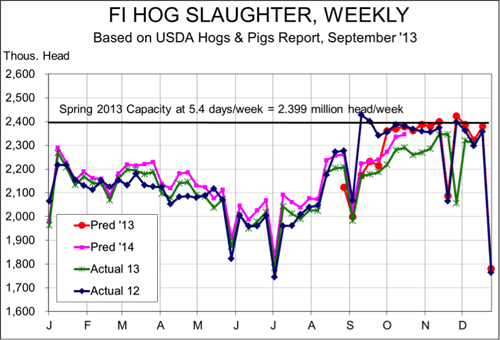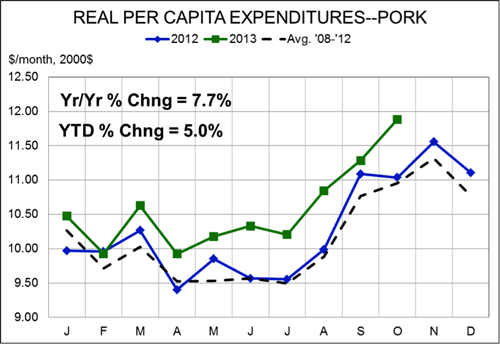



Hog Slaughter Up Last Week; Good Year for Pork Demand
US - Something unusual happened last week: US hog processing plants harvested more pigs than they did one year ago. In fact, that is the first time such a statement could be made since the week of 16 August, writes Steve Meyer in his latest "Market Preview" published in National Hog Farmer.As can be seen in Figure 1, last week’s slaughter run was still below the level suggested by the September Hogs and Pigs Report estimate for the inventory of pigs weighing 50 to 119 lb. back on 1 September. Since 1 September, federally inspected slaughter has been 4.1 per cent smaller than last year, and 2.8 per cent smaller than the level I had forecast based on USDA’s 1 September inventories.

But what will happen now? The September report said we had 0.9 per cent more pigs that weighed less than 50 lb. on 1 September. Those pigs should be coming to packing plants from now through February. September- November and December-February farrowings were expected to be 0.9 per cent and 0.4 per cent larger, respectively, than last year. We would normally add 2 per cent or so to those numbers to account for litter size growth, but Figure 1 has just 1 per cent growth included in the March-June farrowing predictions, which correspond to September - November farrowings. That reduction was a nod to our knowledge of porcine epidemic diarrhea virus (PEDV) losses back in September. We left the 2 per cent litter growth intact for July-August slaughter back in September because we had no idea what PEDV was going to do in the future. PEDV has obviously been more damaging than we expected, so we now think both of those “litter size” enhancements may be too large.
The sum of all of this “add-that-much-and-subtract-this-much” ciphering is that these December numbers may be as close as we get to those September predictions. The good thing for us forecasters, of course, is that new data are coming in the 27 December Hogs and Pigs Report. Let’s hope it is more helpful than the September report was.
For anyone who noticed last week’s meat and poultry forecasts in the World Agricultural Supply and Demand Estimates (WASDE) Report, you have a lot of company in wondering where USDA came up with a 2.3 per cent increase for pork production next year. Given the pig losses this fall, we have no idea how the industry can get to that level even with higher market weights. There appears to be plenty of disagreement at USDA on this number, and I expect it will be revised downward in January.
While the supply data are far from definitive, pork demand is completing one of its best years in recent memory (See Figure 2). Real per capita expenditures (RPCE) for pork reached $11.88 in October. That number is 7.7 per cent higher than one year ago, the highest monthly figure since November 2010, and the second highest monthly figure since the fall of 2004 when the Atkins Diet was still impacting meat and poultry markets. The robust monthly performance brings total RPCE for pork for 2013 to $105.68, which is 5 per cent higher than last year, and 6 per cent higher than the average for year-to-date RPCE of the past five years.

The driver of October’s excellent performance is the same as for the past six months: A sharp increase in the real (ie. deflated) price paid for pork at the retail level. October’s nominal average retail pork price, according to USDA, was a record-high $3.81 per pound, 9.3 per cent higher than one year ago. Allowing for inflation, the real retail price of pork was up 8.3 per cent while domestic per capita consumption was only 0.6 per cent lower than in October 2012. A healthy increase in price coupled with a small decline in consumption means demand was strong. And that is a story that has been repeated several times this year.
What is driving demand? We know that the determinants of demand are consumers’ tastes and preferences, income levels and the prices of substitute goods. Prices of beef and pork have certainly been positive for pork demand. Income levels have not been helpful until recently. October’s 1 per cent increase in real disposable per capita income is a positive, but really can’t be construed to be a major factor. That leaves taste and preferences, which appear to be quite positive so far this year. While the RPCE growth for pork leads the pack for the major animal protein species, beef (+3.2 per cent) and chicken (+4.1 per cent) are up sharply as well. Only turkey demand is lower this year at -0.7 per cent vs. 2012. Total RPCE for beef, pork, chicken and turkey is up 3.7 per cent year-to-date and will likely finish the year at its highest level since 2007.






